tow RENAULT FLUENCE 2012 1.G Owner's Manual
[x] Cancel search | Manufacturer: RENAULT, Model Year: 2012, Model line: FLUENCE, Model: RENAULT FLUENCE 2012 1.GPages: 241, PDF Size: 6.5 MB
Page 167 of 241
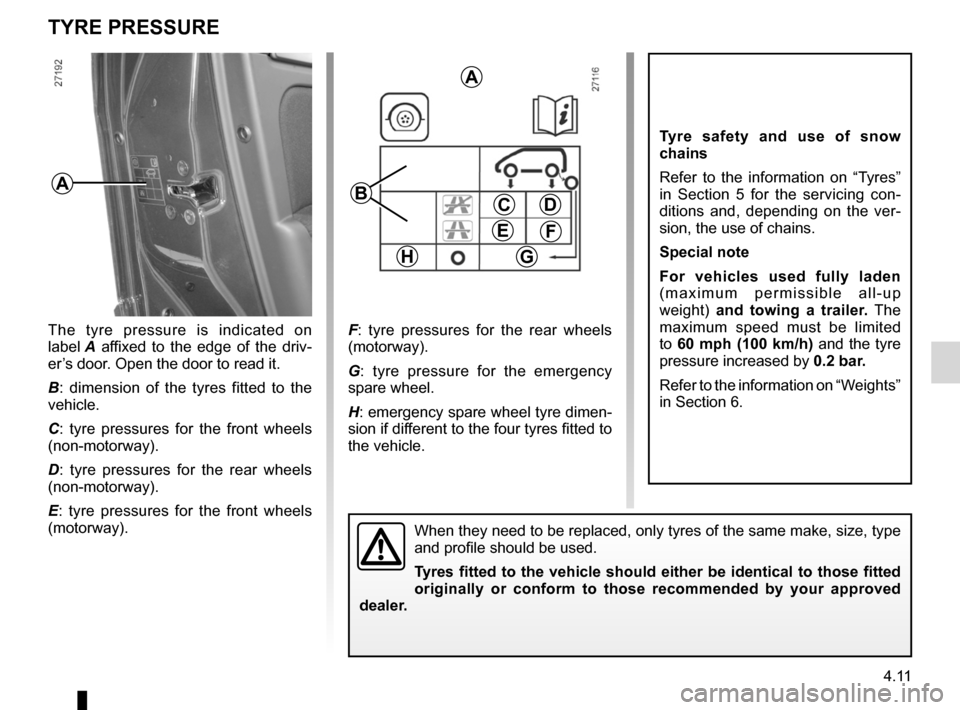
tyre pressure......................................... (up to the end of the DU)
tyre pressures ....................................... (up to the end of the DU)
tyres ...................................................... (up to the end of the DU)
4.11
ENG_UD6333_1
Pression de gonflage des pneumatiques (X95 - B95 - D95 - Renault)
ENG_NU_891_892-7_L38-B32_Renault_4
Tyre Pressure
tyRe pReSSURe
The tyre pressure is indicated on
label A affixed to the edge of the driv -
er’s door. Open the door to read it.
B : dimension of the tyres fitted to the
vehicle.
C : tyre pressures for the front wheels
(non-motorway).
D : tyre pressures for the rear wheels
(non-motorway).
E : tyre pressures for the front wheels
(motorway). F
: tyre pressures for the rear wheels
(motorway).
G : tyre pressure for the emergency
spare wheel.
H: emergency spare wheel tyre dimen -
sion if different to the four tyres fitted to
the vehicle.
t yre safety and use of snow
chains
Refer to the information on “Tyres”
in Section 5 for the servicing con -
ditions and, depending on the ver -
sion, the use of chains.
Special note
For vehicles used fully laden
( m a x i m u m p e r m i s s i b l e a l l - u p
weight) and towing a trailer. The
maximum speed must be limited
to 60 mph (100 km/h) and the tyre
pressure increased by 0.2 bar.
Refer to the information on “Weights”
in Section 6.
CD
Fe
g
A
H
AB
When they need to be replaced, only tyres of the same make, size, type
and profile should be used.
t yres fitted to the vehicle should either be identical to those fitted
originally or conform to those recommended by your approved
dealer.
Page 168 of 241
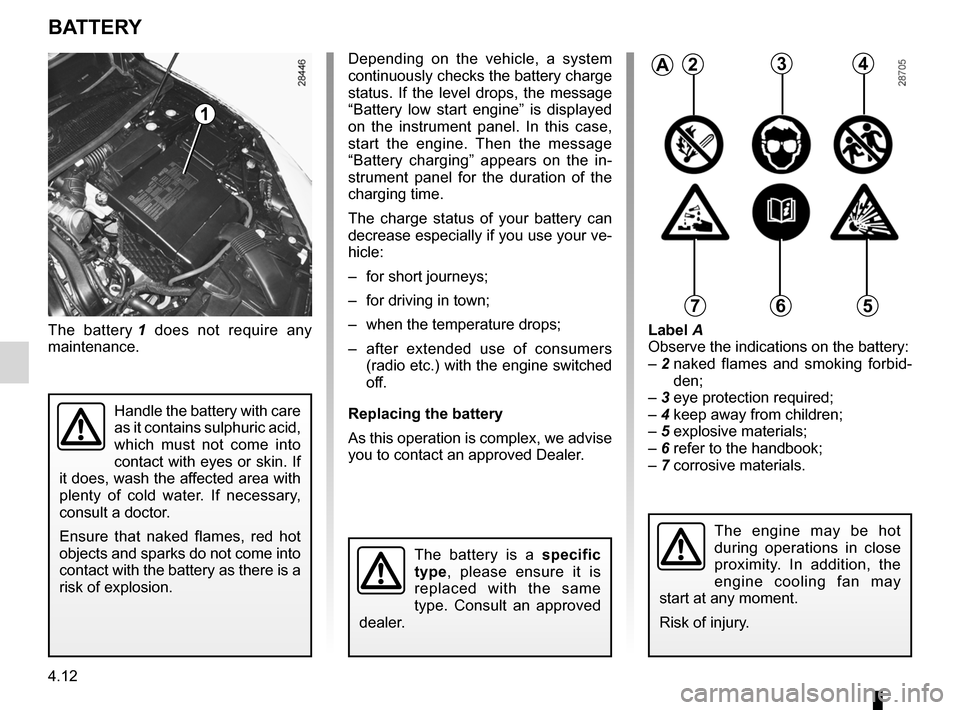
battery................................................... (up to the end of the DU)
4.12
ENG_UD13687_1
Batterie (L38 - X38 - Renault)
ENG_NU_891_892-7_L38-B32_Renault_4
The battery 1 does not require any
maintenance.label A
Observe the indications on the battery:
– 2 naked flames and smoking forbid -
den;
– 3 eye protection required;
– 4 keep away from children;
– 5 explosive materials;
– 6 refer to the handbook;
– 7 corrosive materials.
Battery
The battery is a specific
type , please ensure it is
replaced with the same
type. Consult an approved
dealer.
Handle the battery with care
as it contains sulphuric acid,
which must not come into
contact with eyes or skin. If
it does, wash the affected area with
plenty of cold water. If necessary,
consult a doctor.
Ensure that naked flames, red hot
objects and sparks do not come into
contact with the battery as there is a
risk of explosion.
BA tteR y
Depending on the vehicle, a system
continuously checks the battery charge
status. If the level drops, the message
“Battery low start engine ” is displayed
on the instrument panel. In this case,
start the engine. Then the message
“ Battery charging ” appears on the in -
strument panel for the duration of the
charging time.
The charge status of your battery can
decrease especially if you use your ve-
hicle:
– for short journeys;
– for driving in town;
– when the temperature drops;
– after extended use of consumers
(radio etc.) with the engine switched
off.
Replacing the battery
As this operation is complex, we advise
you to contact an approved Dealer.
1
The engine may be hot
during operations in close
proximity. In addition, the
engine cooling fan may
start at any moment.
Risk of injury.
A234
567
Page 173 of 241
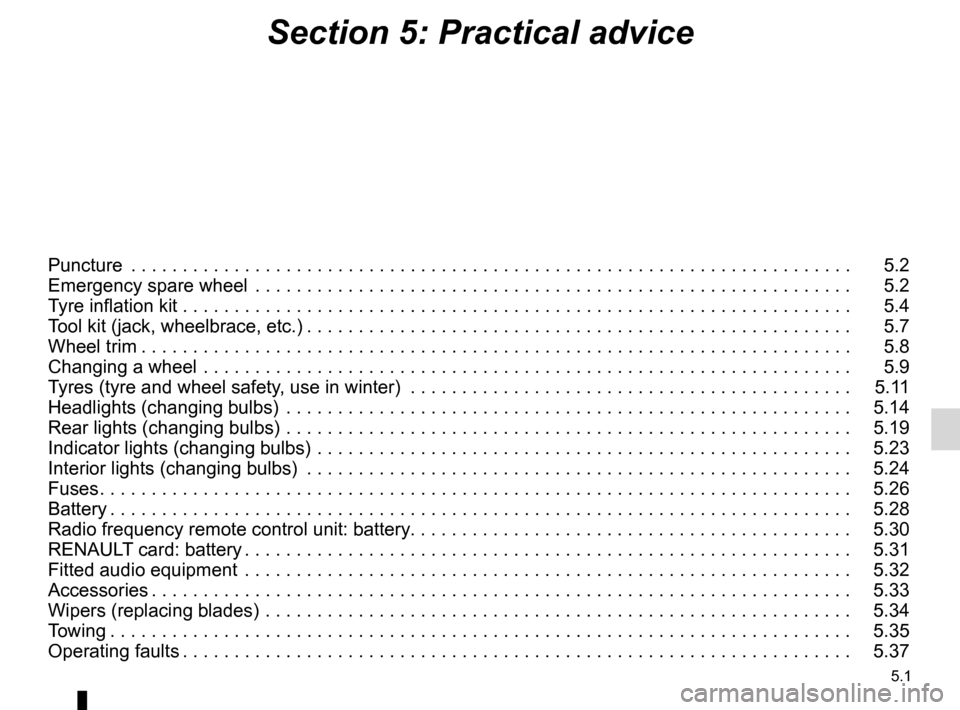
5.1
ENG_UD27184_7
Sommaire 5 (L38 - X38 - Renault)
ENG_NU_891_892-7_L38-B32_Renault_5
Section 5: Practical advice
Puncture . . . . . . . . . . . . . . . . . . . . . . . . . . . . . . . . . . . . . . . . . . . . . . . . . . . . . . . . . . . . . . . . . . . . . . 5.2
Emergency spare wheel . . . . . . . . . . . . . . . . . . . . . . . . . . . . . . . . . . . . . . . . . . . . . . . . . . . . . . . . . . 5.2
Tyre inflation kit . . . . . . . . . . . . . . . . . . . . . . . . . . . . . . . . . . . . . . . . . . . . . . . . . . . . . . . . . . . . . . . . . 5.4
Tool kit (jack, wheelbrace, etc.) . . . . . . . . . . . . . . . . . . . . . . . . . . . . . . . . . . . . . . . . . . . . . . . . . . . . . 5.7
Wheel trim . . . . . . . . . . . . . . . . . . . . . . . . . . . . . . . . . . . . . . . . . . . . . . . . . . . . . . . . . . . . . . . . . . . . . 5.8
Changing a wheel . . . . . . . . . . . . . . . . . . . . . . . . . . . . . . . . . . . . . . . . . . . . . . . . . . . . . . . . . . . . . . . 5.9
Tyres (tyre and wheel safety, use in winter) . . . . . . . . . . . . . . . . . . . . . . . . . . . . . . . . . . . . . . . . . . . 5.11
Headlights (changing bulbs) . . . . . . . . . . . . . . . . . . . . . . . . . . . . . . . . . . . . . . . . . . . . . . . . . . . . . . . 5.14
Rear lights (changing bulbs) . . . . . . . . . . . . . . . . . . . . . . . . . . . . . . . . . . . . . . . . . . . . . . . . . . . . . . . 5.19
Indicator lights (changing bulbs) . . . . . . . . . . . . . . . . . . . . . . . . . . . . . . . . . . . . . . . . . . . . . . . . . . . . 5.23
Interior lights (changing bulbs) . . . . . . . . . . . . . . . . . . . . . . . . . . . . . . . . . . . . . . . . . . . . . . . . . . . . . 5.24
Fuses . . . . . . . . . . . . . . . . . . . . . . . . . . . . . . . . . . . . . . . . . . . . . . . . . . . . . . . . . . . . . . . . . . . . . . . . . 5.26
Battery . . . . . . . . . . . . . . . . . . . . . . . . . . . . . . . . . . . . . . . . . . . . . . . . . . . . . . . . . . . . . . . . . . . . . . . . 5.28
Radio frequency remote control unit: battery . . . . . . . . . . . . . . . . . . . . . . . . . . . . . . . . . . . . \
. . . . . . . 5.30
RENAULT card: battery . . . . . . . . . . . . . . . . . . . . . . . . . . . . . . . . . . . . . . . . . . . . . . . . . . . . . . . . . . . 5.31
Fitted audio equipment . . . . . . . . . . . . . . . . . . . . . . . . . . . . . . . . . . . . . . . . . . . . . . . . . . . . . . . . . . . 5.32
Accessories . . . . . . . . . . . . . . . . . . . . . . . . . . . . . . . . . . . . . . . . . . . . . . . . . . . . . . . . . . . . . . . . . . . . 5.33
Wipers (replacing blades) . . . . . . . . . . . . . . . . . . . . . . . . . . . . . . . . . . . . . . . . . . . . . . . . . . . . . . . . . 5.34
Towing . . . . . . . . . . . . . . . . . . . . . . . . . . . . . . . . . . . . . . . . . . . . . . . . . . . . . . . . . . . . . . . . . . . . . . . . 5.35
Operating faults . . . . . . . . . . . . . . . . . . . . . . . . . . . . . . . . . . . . . . . . . . . . . . . . . . . . . . . . . . . . . . . . . 5.37
Page 180 of 241
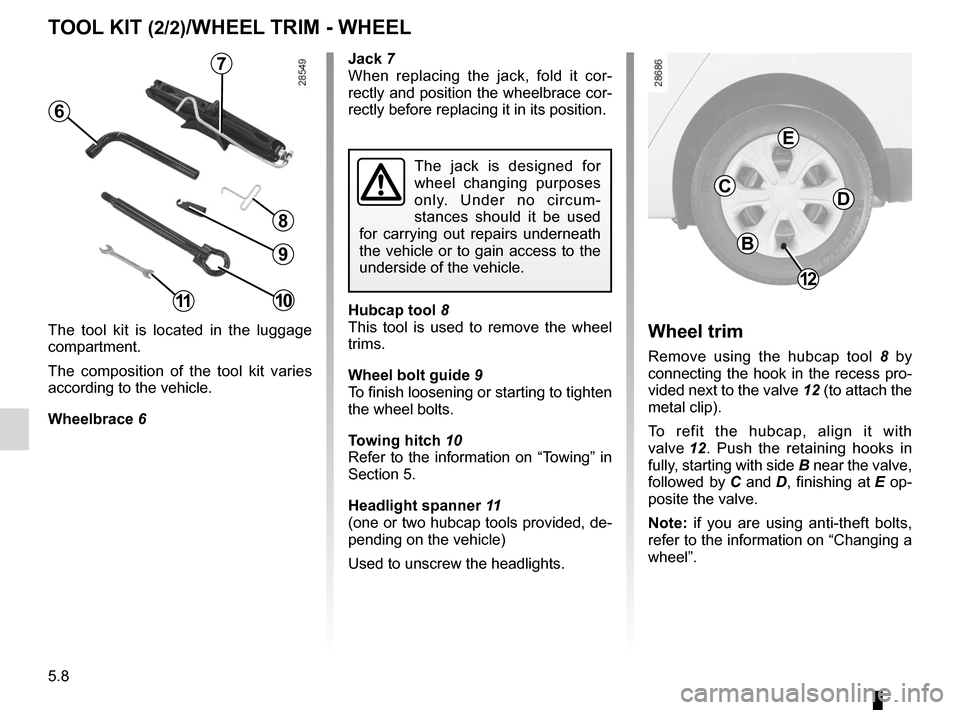
hubcap tool ............................................................ (current page)
wheel trim .............................................................. (current page)
5.8
ENG_UD23778_4
Bloc-outils (L38 - X38 - Renault)
ENG_NU_891_892-7_L38-B32_Renault_5
Wheel trim
The tool kit is located in the luggage
compartment.
The composition of the tool kit varies
according to the vehicle.
wheelbrace 6 Jack 7
When replacing the jack, fold it cor
-
rectly and position the wheelbrace cor-
rectly before replacing it in its position.
hubcap tool 8
This tool is used to remove the wheel
trims.
wheel bolt guide 9
To finish loosening or starting to tighten
the wheel bolts.
t owing hitch 10
Refer to the information on “Towing” in
Section 5.
headlight spanner 11
(one or two hubcap tools provided, de-
pending on the vehicle)
Used to unscrew the headlights.
7
6
8
10
wheel trim
Remove using the hubcap tool 8 by
connecting the hook in the recess pro-
vided next to the valve 12 (to attach the
metal clip).
To refit the hubcap, align it with
valve 12 . Push the retaining hooks in
fully, starting with side B near the valve,
followed by C and D, finishing at E op-
posite the valve.
n ote: if you are using anti-theft bolts,
refer to the information on “Changing a
wheel”.
12
B
cD
e
9
11
t OOl KIt (2/2)/wheel trIm - wheel
The jack is designed for
wheel changing purposes
only. Under no circum -
stances should it be used
for carrying out repairs underneath
the vehicle or to gain access to the
underside of the vehicle.
Page 192 of 241
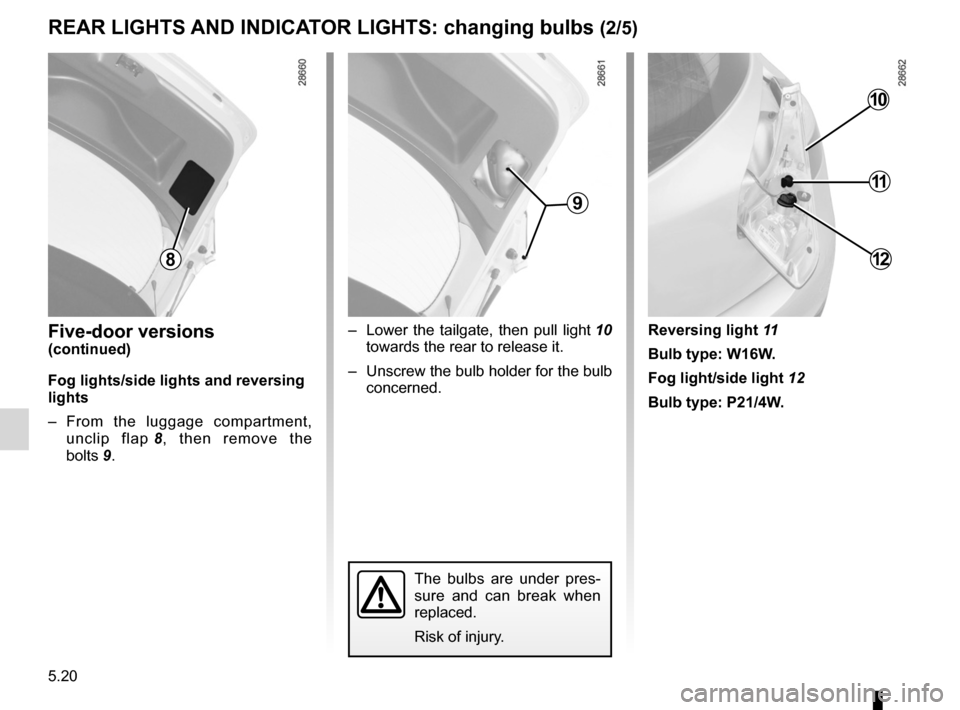
5.20
ENG_UD21378_2
Feux arrière et latéraux : remplacement des lampes (L38 - X38 - R\
enault)
ENG_NU_891_892-7_L38-B32_Renault_5
Jaune NoirNoir texte
rear lIghts anD InDIcatOr lIghts: changing bulbs (2/5)
Five-door versions
(continued)
Fog lights/side lights and reversing
lights
– From the luggage compartment,
unclip flap 8 , then remove the
bolts 9.
– Lower the tailgate, then pull light 10
towards the rear to release it.
– Unscrew the bulb holder for the bulb
concerned.
10
11
9
12
reversing light 11
Bulb type: w16w .
Fog light/side light 12
Bulb type: P21/4w .
The bulbs are under pres -
sure and can break when
replaced.
Risk of injury.
8
Page 195 of 241
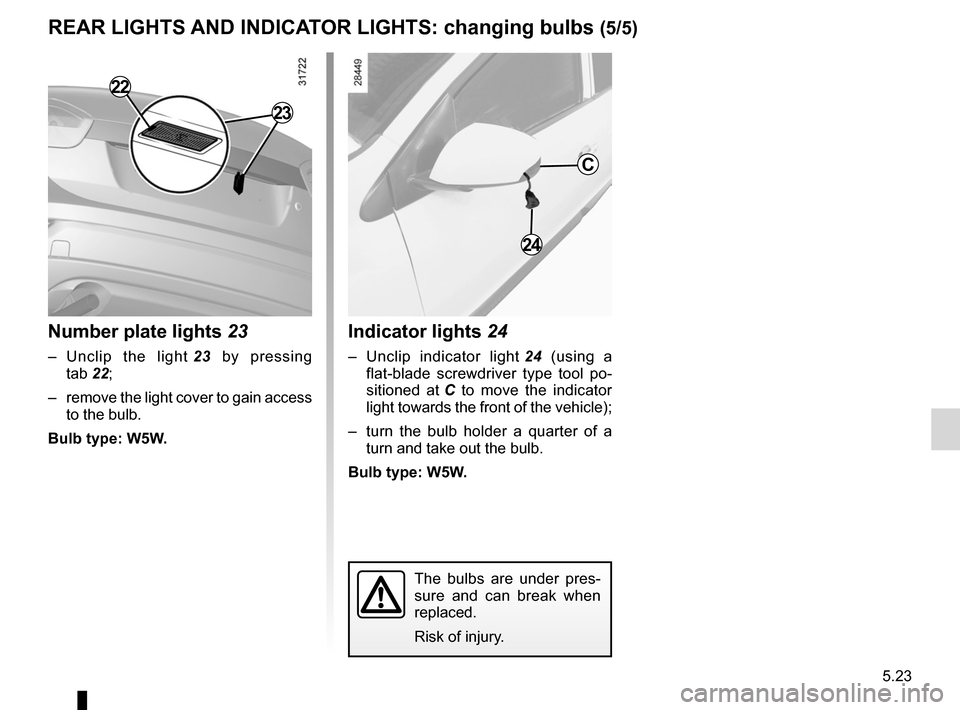
side indicator lightschanging bulbs ................................................. (current page)
lights: number plate lights .......................................... (current page)
JauneNoirNoir texte
5.23
ENG_UD21378_2
Feux arrière et latéraux : remplacement des lampes (L38 - X38 - R\
enault)
ENG_NU_891_892-7_L38-B32_Renault_5
Indicator lights 24
– Unclip indicator light 24 (using a
flat-blade screwdriver type tool po -
sitioned at C to move the indicator
light towards the front of the vehicle);
– turn the bulb holder a quarter of a
turn and take out the bulb.
Bulb type: w5w .
Indicator lights (changing bulbs)
rear lIghts anD InDIcatOr lIghts: changing bulbs (5/5)
number plate lights 23
– Unclip the light 23 by pressing
tab 22;
– remove the light cover to gain access
to the bulb.
Bulb type: w5w .
24
c
23
22
The bulbs are under pres -
sure and can break when
replaced.
Risk of injury.
Page 207 of 241
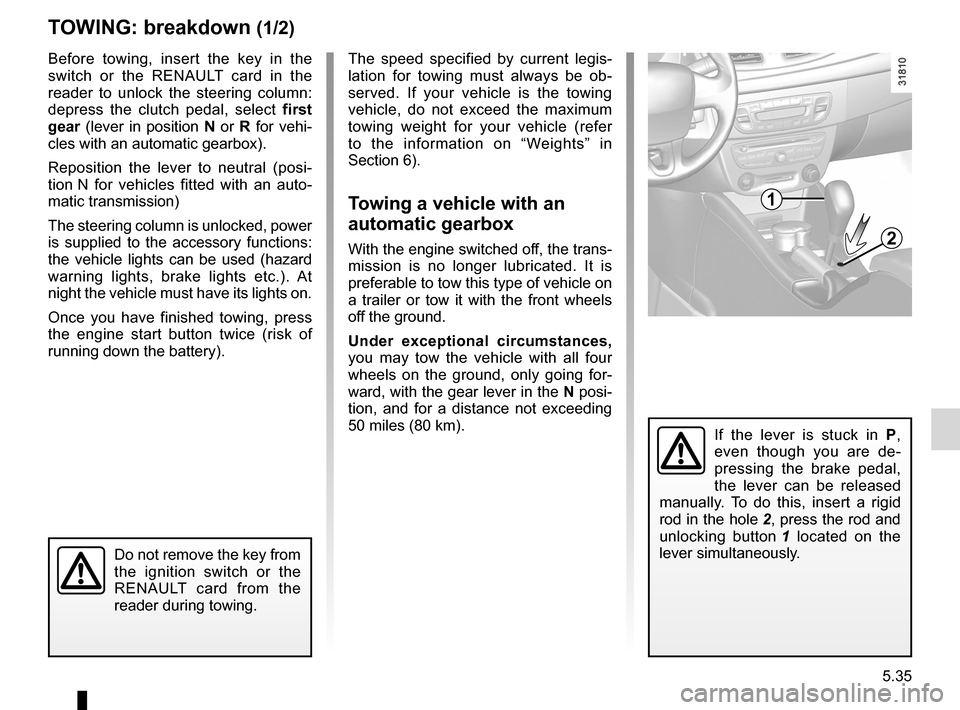
towingbreakdown ...................................... (up to the end of the DU)
towing hitch ........................................... (up to the end of the DU)
5.35
ENG_UD27187_3
Remorquage : dépannage (L38 - X38 - Renault)
ENG_NU_891_892-7_L38-B32_Renault_5
Towing
tOwIng : breakdown (1/2)
Before towing, insert the key in the
switch or the RENAULT card in the
reader to unlock the steering column:
depress the clutch pedal, select first
gear (lever in position n or r for vehi-
cles with an automatic gearbox).
Reposition the lever to neutral (posi -
tion N for vehicles fitted with an auto -
matic transmission)
The steering column is unlocked, power
is supplied to the accessory functions:
the vehicle lights can be used (hazard
warning lights, brake lights etc.). At
night the vehicle must have its lights on.
Once you have finished towing, press
the engine start button twice (risk of
running down the battery). The speed specified by current legis
-
lation for towing must always be ob -
served. If your vehicle is the towing
vehicle, do not exceed the maximum
towing weight for your vehicle (refer
to the information on “Weights” in
Section 6).
t owing a vehicle with an
automatic gearbox
With the engine switched off, the trans-
mission is no longer lubricated. It is
preferable to tow this type of vehicle on
a trailer or tow it with the front wheels
off the ground.
u nder exceptional circumstances,
you may tow the vehicle with all four
wheels on the ground, only going for -
ward, with the gear lever in the n posi-
tion, and for a distance not exceeding
50 miles (80 km).
If the lever is stuck in P,
even though you are de -
pressing the brake pedal,
the lever can be released
manually. To do this, insert a rigid
rod in the hole 2, press the rod and
unlocking button 1 located on the
lever simultaneously.
1
2
Do not remove the key from
the ignition switch or the
RENAULT card from the
reader during towing.
Page 208 of 241
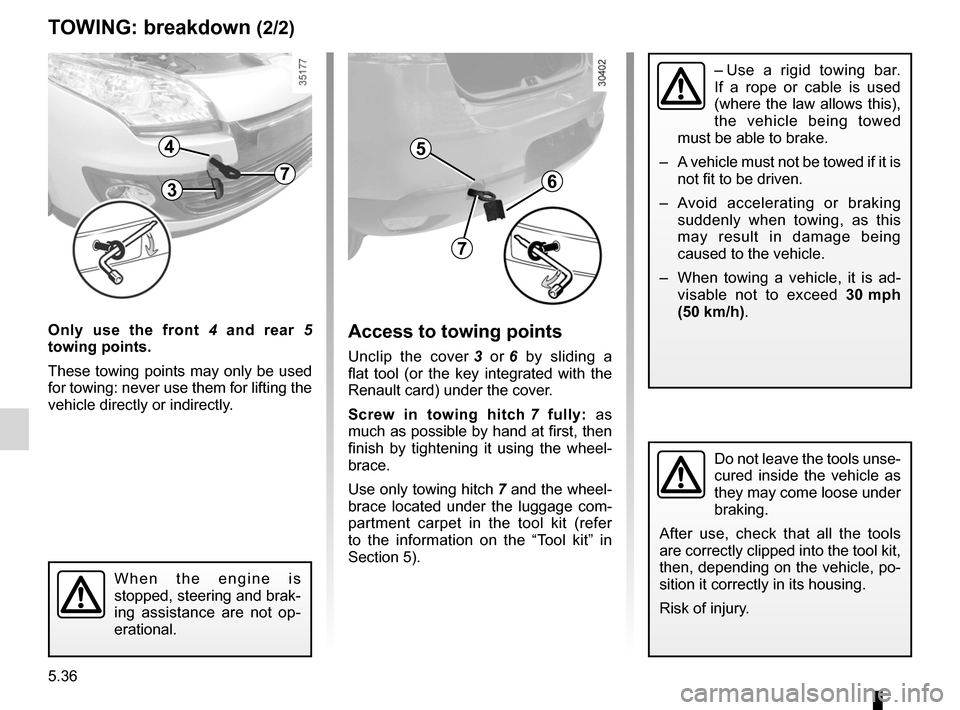
5.36
ENG_UD27187_3
Remorquage : dépannage (L38 - X38 - Renault)
ENG_NU_891_892-7_L38-B32_Renault_5
tOwIng : breakdown (2/2)
Only use the front 4 and rear 5
towing points.
These towing points may only be used
for towing: never use them for lifting the
vehicle directly or indirectly.access to towing points
Unclip the cover 3 or 6 by sliding a
flat tool (or the key integrated with the
Renault card) under the cover.
s crew in towing hitch 7 fully: as
much as possible by hand at first, then
finish by tightening it using the wheel -
brace.
Use only towing hitch 7 and the wheel -
brace located under the luggage com -
partment carpet in the tool kit (refer
to the information on the “Tool kit” in
Section 5).
W h e n t h e e n g i n e i s
stopped, steering and brak-
ing assistance are not op -
erational.
Do not leave the tools unse-
cured inside the vehicle as
they may come loose under
braking.
After use, check that all the tools
are correctly clipped into the tool kit,
then, depending on the vehicle, po-
sition it correctly in its housing.
Risk of injury.
5
6
7
– Use a rigid towing bar.
If a rope or cable is used
(where the law allows this),
the vehicle being towed
must be able to brake.
– A vehicle must not be towed if it is
not fit to be driven.
– Avoid accelerating or braking
suddenly when towing, as this
may result in damage being
caused to the vehicle.
– When towing a vehicle, it is ad -
visable not to exceed 30 mph
(50 km/h).
37
4
Page 217 of 241
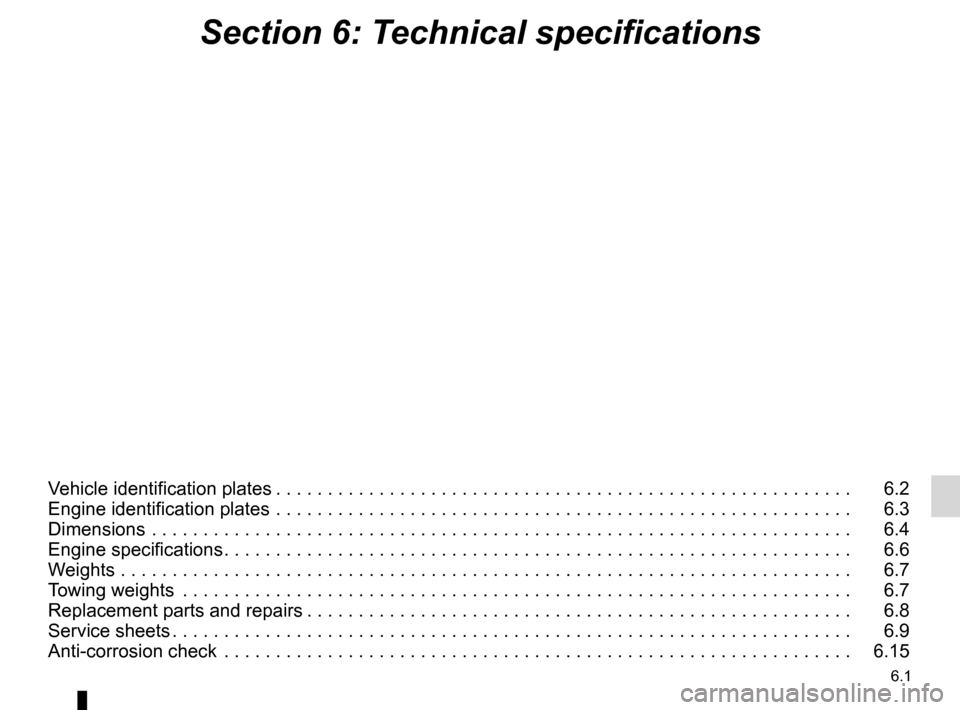
6.1
ENG_UD27188_7
Sommaire 6 (L38 - X38 - Renault)
ENG_NU_891_892-7_L38-B32_Renault_6
Section 6: Technical specifications
Vehicle identification plates . . . . . . . . . . . . . . . . . . . . . . . . . . . . . . . . . . . . . . . . . . . . . . . . . . . . . . . . 6.2
Engine identification plates . . . . . . . . . . . . . . . . . . . . . . . . . . . . . . . . . . . . . . . . . . . . . . . . . . . . . . . . 6.3
Dimensions . . . . . . . . . . . . . . . . . . . . . . . . . . . . . . . . . . . . . . . . . . . . . . . . . . . . . . . . . . . . . . . . . . . . 6.4
Engine specifications . . . . . . . . . . . . . . . . . . . . . . . . . . . . . . . . . . . . . . . . . . . . . . . . . . . . . . . . . . . . . 6.6
Weights . . . . . . . . . . . . . . . . . . . . . . . . . . . . . . . . . . . . . . . . . . . . . . . . . . . . . . . . . . . . . . . . . . . . . . . 6.7
Towing weights . . . . . . . . . . . . . . . . . . . . . . . . . . . . . . . . . . . . . . . . . . . . . . . . . . . . . . . . . . . . . . . . . 6.7
Replacement parts and repairs . . . . . . . . . . . . . . . . . . . . . . . . . . . . . . . . . . . . . . . . . . . . . . . . . . . . . 6.8
Service sheets . . . . . . . . . . . . . . . . . . . . . . . . . . . . . . . . . . . . . . . . . . . . . . . . . . . . . . . . . . . . . . . . . . 6.9
Anti-corrosion check . . . . . . . . . . . . . . . . . . . . . . . . . . . . . . . . . . . . . . . . . . . . . . . . . . . . . . . . . . . . . 6.15
Page 223 of 241
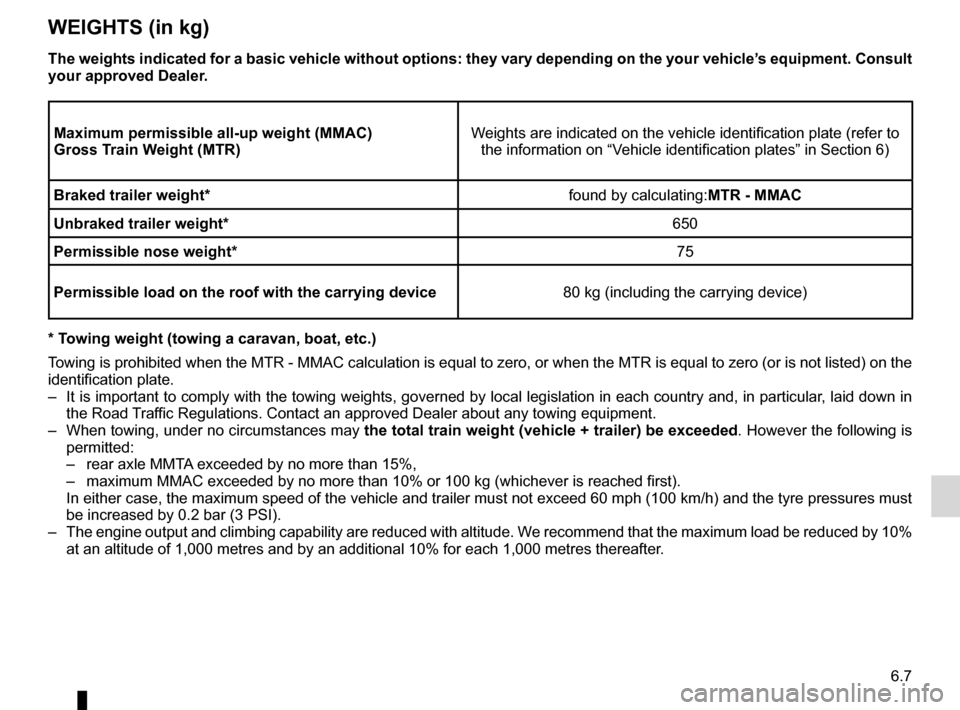
technical specifications ......................... (up to the end of the DU)
towing a caravan .................................. (up to the end of the DU)
towing weights ...................................... (up to the end of the DU)
weights ................................................. (up to the end of the DU)
transporting objects on the roof ....................................... (up to the end of the DU)
6.7
ENG_UD27190_5
Masse en Kg (L38 - X38 - Renault)
ENG_NU_891_892-7_L38-B32_Renault_6
Weights
Towing weights
Weights (in kg)
the weights indicated for a basic vehicle without options: they vary depending on the your vehicle’s equipment. consult
your approved dealer.
maximum permissible all-up weight (mmac)
gross t rain Weight (mtR) Weights are indicated on the vehicle identification plate (refer to
the information on “Vehicle identification plates” in Section 6)
Braked trailer weight* found by calculating:mtR - mmac
Unbraked trailer weight* 650
permissible nose weight* 75
permissible load on the roof with the carrying device 80 kg (including the carrying device)
* t owing weight (towing a caravan, boat, etc.)
Towing is prohibited when the MTR - MMAC calculation is equal to zero, or when the MTR is equal to zero (or is not listed) on the
identification plate.
– It is important to comply with the towing weights, governed by local legislation in each country and, in particular, laid down in
the Road Traffic Regulations. Contact an approved Dealer about any towing equipment.
– When towing, under no circumstances may the total train weight (vehicle + trailer) be exceeded . However the following is
permitted:
– rear axle MMTA exceeded by no more than 15%,
– maximum MMAC exceeded by no more than 10% or 100 kg (whichever is reached first).
In either case, the maximum speed of the vehicle and trailer must not exceed 60 mph (100 km/h) and the tyre pressures must
be increased by 0.2 bar (3 PSI).
– The engine output and climbing capability are reduced with altitude. We recommend that the maximum load be reduced by 10%
at an altitude of 1,000 metres and by an additional 10% for each 1,000 m\
etres thereafter.